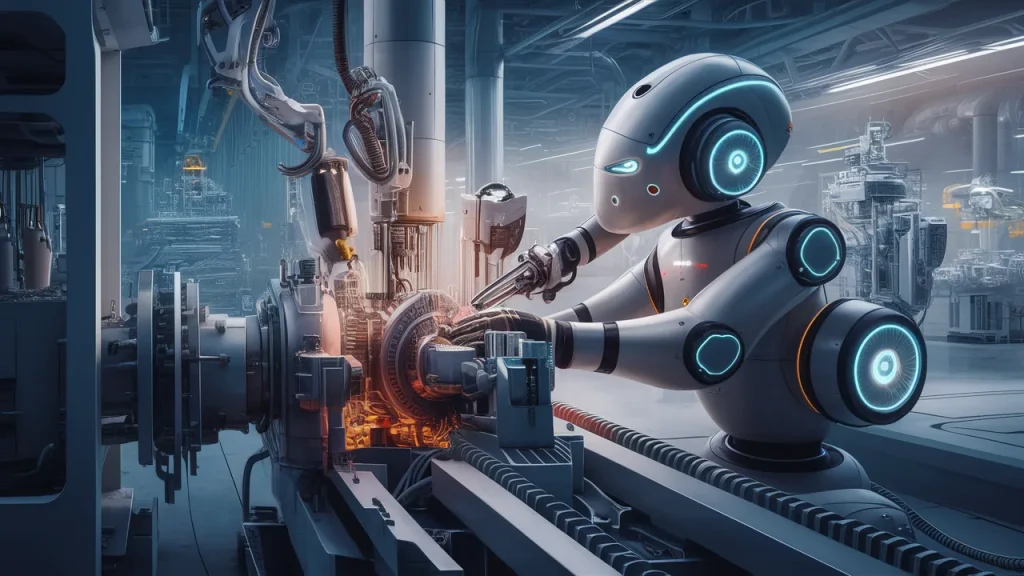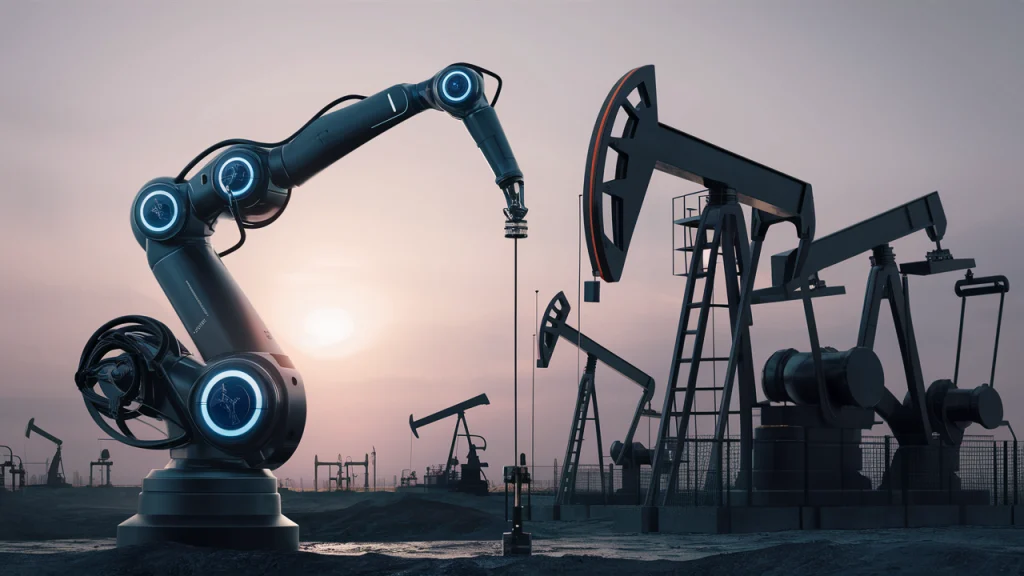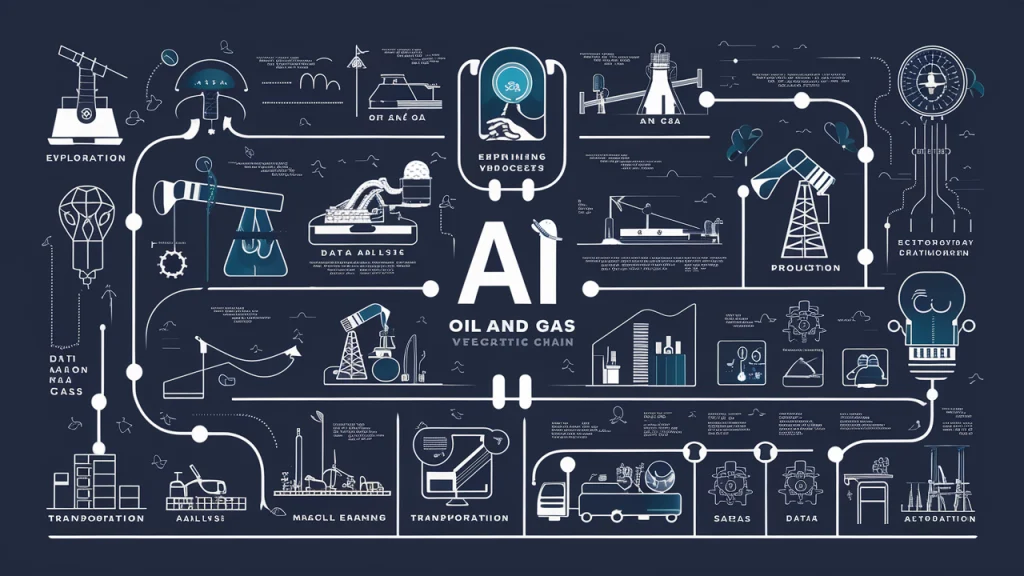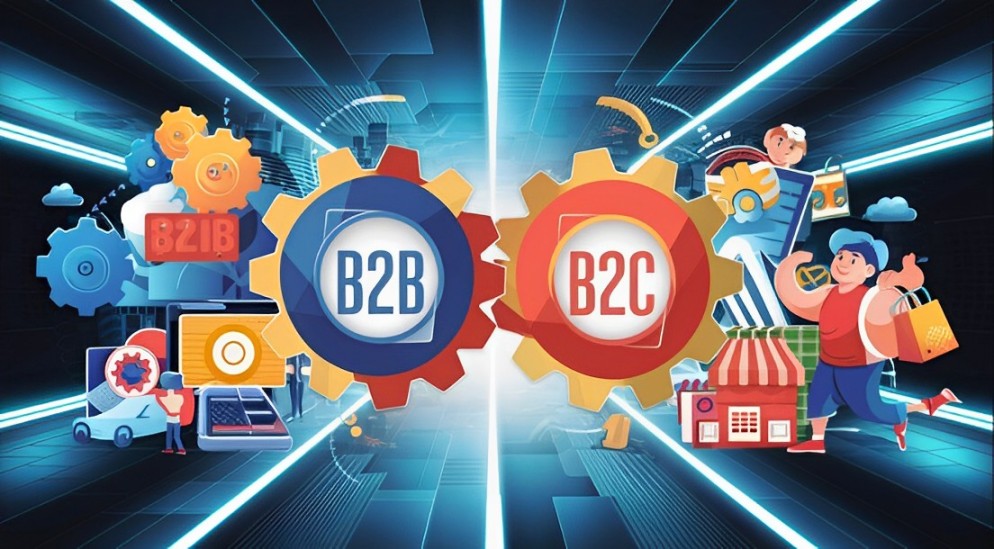Keeping things running safely and smoothly is super important in the oil and gas industry. It helps avoid problems, saves time, and brings in more money.
However, the old way of fixing things only when they break or are on a set schedule can waste money and be risky.
With AI in the oil and gas industry, maintenance teams can focus on high-priority tasks.
Let us look at how AI is making a big difference in taking care of oil and gas equipment, what it does, its good points, and what we might see from this cool tech.
Understanding AI’s Role in Keeping Oil and Gas Equipment Running Smoothly
What Does AI Mean for Oil and Gas Equipment Care?
Artificial Intelligence Solutions is a smart way to help keep machinery and equipment in tip-top shape.
It uses fancy computer programs to make better choices on when to fix stuff before it breaks down.
With AI, we can get a heads-up about potential problems and figure out the best time to do maintenance work, making everything more efficient and saving both time and cash.
This clever tech works by keeping an eye on lots of data from different places, like sensors attached to machines, helping make quick and accurate decisions on what needs fixing.
How Did AI Start Helping the Oil and Gas Industry?
At first, it was all about looking through data better so they could find where oil and gas were hiding under the ground more easily. For instance, using AI made sense of complex rock data to spot oil spots better than before.
As AI got better over time, its uses grew bigger.
The last ten years saw it becoming super important for keeping equipment working well because it helps cut costs and make things run smoother.
In the beginning, fitting AI into their systems was tough for companies since they had lots of complicated operations going on and tons of information coming in all the time.
But as computers got faster and we figured out how to store big amounts of data without too much hassle, using AI became way easier.
Nowadays, loads of oil and gas firms are putting money into AI technologies to help them compete better and take good care of their old equipment.
Why We Need Smart Maintenance in Oil and Gas
The oil and gas world faces big problems that smart, AI-driven care can help solve:
- Old Equipment: A lot of the gear and pipes used are really old, which makes them more likely to break down and cost a lot to fix.
- Money Lost from Surprise Breakdowns: When stuff breaks without warning, it stops production, and fixing it fast costs a lot of money.
- Safety Worries: If equipment breaks, it could hurt people working there or harm the environment.
- Following Rules: There are strict rules to keep everything safe and not harm the planet. It’s hard to meet these standards without new technology.
- Outdated Care Methods Don’t Cut It: The old ways of waiting for things to break or checking them on a schedule often waste time and money.
AI can change maintenance for the better by being proactive, saving money, and making things more efficient.
Smart Maintenance with AI

Smart maintenance using AI to figure out when machines might break down. This way, repairs can be done just in time to stop things from suddenly stopping work.
It’s different from fixing things only after they’ve broken (reactive maintenance) and doing regular check-ups no matter how the machine is doing (scheduled maintenance).
The benefits of smart maintenance include:
- Less Downtime: By guessing when problems might happen, smart maintenance keeps things running without unexpected stops.
- Saving Money: Doing maintenance only when it’s needed cuts back on costs for unnecessary check-ups.
- Machines Last Longer: Keeping machines in top shape means they can work well for a longer time.
- Safer Workplaces: Avoiding sudden breakdowns helps keep everyone at work and the environment safer.
How AI and Learning Machines Make Smart Maintenance Possible
AI and learning machines are key to making smart maintenance work. Here’s how they team up for better upkeep:
- Gathering Data: Special sensors and internet-connected gadgets gather all sorts of info like heat, pressure, shakes, etc., from machines. This info keeps flowing into the main system for review.
- Understanding the Data: AI programs look over this info to spot patterns or unusual signs.
Learning machines get better over time by studying old data so they can tell what normal looks like vs. when there might be trouble ahead.
- Smart Guesses: These AI tools make educated guesses on when a machine might need fixing or how long it has until it won’t work as well anymore. This helps plan out when to do fixes or check-ups.
- Guided Decisions: The smart tips from these tools help repair teams know the best times and places for maintenance, keeping everything running smoothly and efficiently.
Key Points: Gathering Information, Understanding It, and Making Use of What We Learn
- Gathering Information: Getting good and full information is at the heart of keeping machines running without hiccups.
Things like sensors and internet-connected devices are really important for picking up bits of info from all different parts of a machine.
For instance, a sensor might watch how a pump shakes to see if anything odd that could mean trouble pops up.
- Understanding It: Now that we have gathered all of this data, it is time to use AI technology to thoroughly examine everything.
This tech examines the data, looking for any strange or unexpected trends that would indicate an issue.
Machine learning comes in handy here, as it learns from experience and improves its predictions over time.
- Making Use of What We Learn: The big win with predictive upkeep is finding out things we can do something about.
These little bits of wisdom could alert a team to the possibility that a piece of equipment may malfunction soon, allowing them to take preventative measures and make repairs before things get worse.
This proactive approach keeps things running smoothly and helps prevent unexpected equipment failures.
AI in Keeping Oil and Gas Equipment Up and Running
Artificial Intelligence (AI) is changing the game in maintaining oil and gas tools. It boosts how well things work, spots issues before they happen, and helps plan upkeep better.
Here’s a look at some big ways AI is helping out.
Watching Over Equipment and Guessing When It Might Break
Gathering Data in the Moment with Sensors and IoT
- Special sensors and Internet of Things (IoT) stuff are super important for getting info right away from gear.
- They check out things like how hot something is, pressure levels, shaking, and how much stuff is flowing.
- This gear keeps an eye on things all the time and sends what it finds to a main spot for checking out.
- Like, if sensors notice a pump is shaking more than usual, that could mean there’s trouble.
- Having this info means you can always know how your equipment is doing.
Using AI to Understand How Equipment Is Doing
- AI steps in to make sense of all the data from sensors. It looks for patterns or anything odd that people might not catch.
- Machine learning gets smarter by looking at past data to get what normal looks like. If something’s off, AI points it out as something to look into.
- This smart tech can go through tons of data fast, offering tips that help catch problems early on.
How Predictive Models Prevent Equipment Failures
- Predictive models use data from AI to guess when machines might stop working.
- They can tell how long equipment will last, so maintenance teams can fix things before they break.
- For instance, if a model thinks a compressor will break next month, workers can plan to repair it ahead of time. This stops unexpected breaks and keeps things running smoothly.
- These models help schedule repairs at the best times to avoid work interruptions.
Predictive analytics powered by AI in the oil and gas industry can save companies millions of dollars.
Keeping Equipment Safe with AI
- AI figures out which machines are at risk of breaking down. It checks how they’re doing and decides which ones need fixing first.
- This means machines that could cause big problems if they broke are fixed first.
- By focusing on these risky machines, businesses can avoid serious issues and keep operations going smoothly.
Making Inspections and Maintenance Smarter
- AI decides the best times for machine check-ups based on their actual condition, not just a set schedule.
- This approach skips unnecessary checks and puts effort into areas that need it.
- For example, if there’s a chance a pipeline could rust, AI sets up an inspection right away.
- Smart planning like this makes sure maintenance is efficient and focused where it’s needed most.
Corrosion Monitoring and Mitigation Strategies
- In the oil and gas industry, rust is a big deal. AI watches for signs of rust and predicts where it might happen.
- Sensors track things like wetness and what chemicals are present that can lead to rust. AI uses this info to spot potential rust spots before they’re a problem.
- Then, plans are made to stop the rust based on these predictions, which helps assets last longer and prevents breakdowns.
Best Ways to Plan Maintenance Work
Using data and smart computer tools, we can guess what might happen in the future.
This helps in making good plans for fixing and taking care of things before they break.
This way, we choose the best times to fix things so that everything works fine without too much or too little maintenance.
Guessing When to Fix Things
- By looking at how machines are used and their condition, we can figure out the right time to fix them.
- If we know a certain part usually breaks after being used a lot, we can fix it before it breaks.
- Doing this makes sure things are fixed exactly when needed, avoiding both unnecessary fixes and situations where something isn’t fixed soon enough.
Making Good Use of Resources and Managing Parts
- Figuring out when and where fixes will be needed helps make sure we have the right people and parts ready. This means less rushing around ordering parts last minute.
- For example, if we know which parts we’ll need ahead of time, we can manage our stock better and save money.
- Having everything planned out means maintenance teams can do their job well without any hold-ups.
Keeping Equipment Running Smoothly
- In industries like oil and gas where stopping production suddenly is very expensive, guessing when machines might fail and planning fixes beforehand saves a lot of trouble.
- By keeping an eye out for problems before they lead to machine breakdowns, we avoid unexpected stops in work.
- This means continuous production and saving on emergency fixes or losing money from not being able to produce.
Using AI to Find and Fix Problems
- AI analyzes data from monitoring to identify issues and their causes. This facilitates comprehending the cause of an issue and potential solutions.
- AI can analyze the data, for example, to determine whether a pump’s abnormal vibrations are caused by misaligned parts, worn-out parts, or something else entirely.
- Finding the main reason for a problem helps fix the actual issue instead of just dealing with what’s happening on the surface, leading to better repairs.
Preventive Maintenance Depending on the Real Asset Situation
- Rather than following a set schedule, maintenance is carried out according to the equipment’s actual state when condition-based monitoring is used.
- This reduces pointless jobs and concentrates efforts where they are most needed by only performing maintenance when it is necessary.
- By keeping equipment in optimal condition and prolonging its lifespan, proactive maintenance based on actual asset conditions lowers the chance of unplanned failures.
The Advantages of Using AI for Keeping Oil and Gas Operations Running Smoothly

AI in the oil and gas industry enables real-time monitoring of machinery and infrastructure.
Making Things Work Better and Avoiding Being Idle
- Making Upkeep Easier: AI makes keeping things up easier by guessing when machines will need fixing. This means people can fix things just at the right time, getting rid of the guesswork in old ways of maintenance that might miss the mark or be overdone.
- Stopping Surprise Breakdowns: With AI’s help in predictive maintenance, it can spot possible machine breakdowns before they occur.
Fixing problems early stops sudden equipment failures that can cost a lot and mess up work schedules.
- Watching Over Equipment All the Time: Sensors and IoT gadgets keep an eye on how well equipment is working around the clock.
Spotting anything odd right away helps fix issues fast, which means less time when things are not working.
By targeting these areas, AI plays a vital role in making sure oil and gas operations are more reliable and efficient.
Making Things Last Longer and Saving Money on Upkeep
- Looking Ahead to Keep Things Running: Using AI, we can take care of things before problems even start.
This way, we look at what the equipment needs instead of just following a set schedule. It helps avoid extra wear and tear, making stuff last longer.
- Smart Fixes Save Money: With AI’s help, we know exactly when something needs fixing, so we only do the work that’s needed.
This smart way of doing things means we don’t waste money on unneeded repairs.
- Using Resources Wisely: AI also makes sure we use our maintenance team and resources in the smartest way possible.
It figures out exactly what each piece of equipment needs, so the team can focus their efforts where it count most.
Making Workplaces Safer and Sticking to the Rules
- Less Chance of Things Going Wrong: AI helps avoid accidents by forecasting when equipment might break.
This keeps everyone safer since well-looked-after gear doesn’t usually break down in a way that could cause harm.
- Following Safety and Environmental Laws: The oil and gas sector has to follow a lot of rules about keeping people and nature safe.
AI assists in this by keeping equipment in tip-top shape and tracking all the upkeep work that’s done.
- Watching Out for Danger: AI is always on the lookout for dangerous situations, like when there’s a risk of leaking gas or pressure getting too high.
Spotting these risks early lets companies act fast to prevent accidents, making sure everyone stays safe at work.
Boosting Work and Making More Money
- Working Smarter: Not Harder: Using AI means maintaining things that can be done smarter, saving time and resources. These savings mean the company spends less money and makes more profit.
- Planning Better for What’s Ahead: When equipment works reliably thanks to AI, companies can schedule their work more accurately.
- Hitting production goals becomes easier with reliable gear, helping the company’s bottom line.
Smarter Choices with Help from Data
- Looking Deep into Data: AI looks at lots and lots of data from different places to give a full picture of how machines are doing and when they need care. This big-picture view helps those who look after equipment to make smart choices.
- Seeing Into the Future: AI predicts what might go wrong before it happens, helping plan maintenance better and allocate resources wisely.
- Crafting Smarter Plans Based on Facts: By understanding trends and patterns shown by AI, businesses can come up with better ways to look after their equipment.
These strategies are grounded in real information, so they’re more likely to work well.
Overcoming Challenges and Successful Implementation
To make AI work well in oil and gas upkeep, we face a few tough spots, but there are good ways to nail it.
Data Quality and Integration Considerations
- Top-Notch Data: AI needs great data. If the data’s bad, things won’t work right. Making sure all the data is correct, consistent, and current is super important.
- Mixing Data: It’s key to pull together data from different places like sensors, gadgets, and old records. This lets AI look at everything closely for better guesses and ideas.
- Breaking Down Walls: Data often gets trapped in its little world within different parts of a company. It’s crucial to break these walls down and have all the data together in one spot.
Skilled Workforce and Training Requirements
- Learning the Ropes: Putting AI into play means you need folks who know about data science, AI tech, and how to keep things running smoothly. Setting up training sessions to grow these skills is vital.
- Keep Learning: AI stuff changes fast. Keeping up by constantly learning new things ensures everyone stays sharp.
- Teamwork Time: Getting AI pros, data nerds, and maintenance crews to work together makes sure the AI solutions fix real problems effectively.
Change Management and User Adoption Strategies
- Handling Changes Well: Adding AI can switch up how things are usually done. You need smart plans to help everyone adjust without a hitch.
- Getting Everyone Onboard: Talking to employees early on and showing them what’s cool about AI can get them excited and supportive. This could mean having classes or simple talks on what’s in it for them.
- Simple-to-Use Tools: Creating AI tools that are easily understood by all contributes to their increased usage.
Team Collaboration Across the Board
- Team Powers Activate: IT (computer whizzes), OT (machinery magic), and maintenance squads need to join forces for awesome AI solutions. Each team adds valuable insights.
- Talk It Out: Keeping everyone talking means no one’s left out of the loop, ensuring projects move smoothly.
- Shared Objectives: Defining shared objectives and goals for AI implementation helps in aligning efforts and ensuring that the solutions developed meet the needs of all stakeholders.
Cybersecurity and Data Privacy Concerns
- Keeping Data Safe: As we use more data for AI, it’s really important to keep that data safe from online dangers. We should use strong security steps to protect personal information.
- Privacy Matters: It’s also key to look after the privacy of important work data. We have to follow rules and guidelines that are about keeping data private.
- Check-ups: Doing check-ups often on how secure our computer systems are can help find and fix weak spots. This makes sure that the data and AI stay safe.
By using AI in the oil and gas industry, companies can optimize their maintenance schedules.
Future Outlook and Emerging Trends
Looking ahead, artificial intelligence (AI) is becoming even more crucial in the oil and gas sector.
We’re on the brink of seeing big changes in how AI helps with upkeep and so much more.
- Getting better at predictions: As AI and its brainy sidekick, machine learning, get smarter, they’ll get good at guessing when gear might break down or need fixing. They’ll learn from tons of data, making their guesses super accurate.
- Learning on the fly: The AI of the future won’t just sit back; it’ll learn as things happen.
- So if something changes: How equipment is doing, AI will tweak its thinking right then and there, keeping up with whatever’s going on.
- Spotting odd stuff better: With sharper machine learning skills, spotting weird changes in how equipment acts will be easier.
- This means knowing the difference between What’s normal and what could be a headache waiting to happen, helping cut down on unnecessary worry over false alarms.
Next up, combining AI with other cool tech:
- IoT (Internet of Things): Pairing AI with IoT gadgets is getting big. These gadgets gather loads of info from sensors attached to machines.
Then AI takes a look at this info to offer hints and make smart guesses. This duo leads to fixing things at just the right time.
- Edge Computing: This is all about handling data right where it happens instead of sending it far away to a server. It makes things faster and lets decisions be made quickly.
With AI in the mix, analyzing data on-site means actions can be taken instantly, which is perfect for places far from anywhere else.
- Blockchain: Imagine having a super secure way to keep track of all fixes done on gear and every tiny detail about machines. That’s a blockchain for you.
When you bring AI into this scenario, you end up with records that are not only safe from being messed with but also simple to get hold of at any time. This builds trust and keeps everyone honest.
Adoption of AI Across the Entire Oil and Gas Value Chain

AI is changing the way we find and use oil and gas from start to finish.
Here’s how:
- Looking for Oil and Drilling: AI helps us understand the earth better so we can find oil and gas faster.
Soon, it will also make drilling safer and more efficient by predicting problems before they happen.
- Making Production Better: AI is going to make getting oil and gas out of the ground smoother.
It looks at how these facilities work to find slow spots or places that need fixing, making sure everything runs without a hitch.
- Keeping the Supply Chain Moving: The oil and gas supply chain is complicated, but AI is here to simplify things.
It forecasts what customers need, keeps just enough inventory, and makes transporting goods cheaper and more reliable.
Increasing Focus on Sustainability and Environmental Impact Reduction
Watching Over the Environment: AI keeps an eye on air and water around oil and gas areas to reduce harm to nature. It uses this data to help companies follow green rules.
- Cutting Down Emissions: By figuring out better ways to use energy, AI helps lower harmful gases that warm our planet.
- Stopping Leaks Before They Start: Analyzing data from pipes and tanks, AI can tell when a spill might happen, preventing environmental damage and saving companies big money in cleanup costs.
Conclusion
The future looks bright for AI in this industry. With newer tech ideas popping up, combining with other cool technologies, caring more about our planet, updating skills, working together, trying new things out, putting money into better systems, and managing data well – companies are setting up for success.
Keeping up with these trends is key for any company wanting to stay ahead in the game of oil and gas.
Engaging with new developments will help them stay competitive and lead the way in making things better for everyone.
What do you think about using AI to help with fixing and looking after the oil and gas industry?
Have you run into any problems or have cool stories about starting to use AI to keep things working well in your place?
FAQs
1) Can only big oil and gas companies use AI for maintenance?
Nope, AI can be super helpful for all kinds of companies, no matter if they’re just starting or are big.
The great thing about AI is that it can change size to fit all kinds of groups because it doesn’t cost too much.
2) Do the guesses AI makes about when things will break work well?
How good these AI guesses are depends on how much info you have and how tricky the problems are that the AI has to learn.
But as AI gets more info, it often gets better at guessing than the old ways of guessing.
3) What kind of info does AI need to help with maintenance?
AI can use lots of different kinds of info, like numbers from sensors, logbooks from equipment, past fixing records, what the weather’s like, and how things are being used.
The more kinds of info it gets, the smarter it becomes at making good guesses.
4) How fast can we start using AI to keep things working?
This varies a lot depending on how big your company is, what kind of tech setup you already have, and how complicated the AI stuff is.
But many AI tools are made to start helping quickly, sometimes in just a few weeks or months.
5) Will people lose their jobs because we’re using more AI in maintenance?
It’s more likely that AI will help people do their jobs even better instead of taking them away completely.
It aims to give useful tips and insights so that individuals doing maintenance jobs can spend more time on tougher problems that need thinking and planning.



